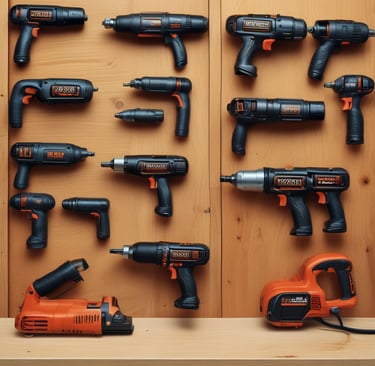Everything You Need to Know About Drills and Drivers
10/26/20255 min read


Understanding the Basics: What Are Drills and Drivers?
Drills and drivers are essential tools in both construction and DIY projects, serving distinct yet complementary functions. A drill is primarily used for creating holes in various materials such as wood, metal, and plastic. Its main function is to rotate a drill bit at high speeds, enabling users to bore into surfaces with precision. On the other hand, a driver is designed for fastening, which involves driving screws, bolts, or similar fasteners into materials. Impact drivers, a popular type of driver, use rotational force and concussive blows to efficiently insert screws, especially in tough materials.
Understanding the difference between these two tools is crucial for effective completion of tasks. While drills focus on drilling holes, drivers excel in fastening components together. This essential difference informs the selection of the right tool for the job. Both drills and drivers come in various configurations, each tailored to meet specific needs in various scenarios.
There are several types of drills available, including corded, cordless, and hammer drills. Corded drills offer consistent power but limit mobility, while cordless variants provide convenience but may require battery management. Hammer drills, in contrast, are specially designed to combine rotary drilling with a hammering action, enabling them to penetrate harder materials like brick or concrete.
When it comes to drivers, options like regular screwdrivers and impact drivers are prevalent. Standard screwdrivers are manual tools that require physical effort to turn screws, whereas impact drivers feature a quick-release chuck that allows for rapid switch between different bits and a powerful mechanism that prevents stripping the screw heads. Each type of drill and driver has its unique features tailored to specific tasks and user preferences, ultimately enhancing efficiency and effectiveness in project execution.
Choosing the Right Tool: Drills vs. Drivers
When faced with the choice between drills and drivers, it is essential to assess the specific requirements of your project. Both tools serve unique purposes, and understanding their distinctive features will guide you to make the right decision. Primarily, drills are designed for creating holes in various materials, while drivers excel at fastening screws and bolts. Recognizing this fundamental difference is crucial in selecting the appropriate tool for your task.
Power is one of the key considerations when differentiating between these two tools. Drills typically come with higher power ratings, allowing them to penetrate harder materials such as metal or masonry. Conversely, drivers are often equipped with adjustable torque settings, which enables users to apply the right amount of force without stripping screws or damaging workpieces. Torque is vital for driving screws effectively, influencing how well the driver performs in specific applications.
Speed settings also play an important role in the functionality of both drills and drivers. Many models offer variable speed options that allow for precise control over the drilling or driving process. A higher speed setting may be preferable for drilling, whereas a lower speed with higher torque is ideal for driving screws. Battery life is another significant factor to consider; for extended projects, opting for a tool with a longer-lasting battery ensures uninterrupted work.
To illustrate, if you are undertaking a home improvement project that involves assembling furniture, a driver would be more suitable due to its ability to efficiently drive screws. Alternatively, if your task requires creating pilot holes for anchors, a drill would be necessary. By evaluating these factors meticulously—power, torque, speed, and battery life—you can confidently determine whether a drill or a driver aligns best with your project needs.
Essential Features to Consider When Buying Drills and Drivers
When it comes to purchasing drills and drivers, prospective buyers should carefully evaluate several essential features to ensure they choose the right tools for their needs. One of the first aspects to consider is the chuck size, which refers to the opening that holds the drill bit securely in place. Common chuck sizes are 1/2 inch and 3/8 inch, with the former typically providing greater versatility for heavier-duty tasks. A larger chuck size can accommodate a wider range of bit styles and sizes, making it a wise choice for varied projects.
Next, the RPM (revolutions per minute) rating is a vital specification that indicates the speed at which a drill or driver operates. Higher RPMs can increase the efficiency of drilling through tough materials, while lower RPMs allow for better control during precision work. It is advisable to select a drill or driver with variable speed settings, providing flexibility for different applications. The ability to adjust RPM according to the task at hand significantly enhances the tool's usability.
Additionally, clutch settings are a critical parameter, particularly for drivers. A tool with multiple clutch settings enables better torque control, thus preventing overdriving screws and damaging the material being worked on. They allow for fine-tuning based on the task, ensuring successful completion of various applications.
Weight also plays a pivotal role in choosing the right tool. A lighter drill or driver often improves maneuverability, especially during prolonged usage. Therefore, users should look for a comfortable balance between weight and power. Brand reliability is another consideration; trusted brands typically provide better quality assurance and customer support. Lastly, ergonomics should not be overlooked. A well-designed handle can significantly affect a user’s comfort and efficiency, especially during extended periods of operation. Considering these features will assist buyers in making well-informed decisions that align with their specific project requirements.
Maintenance and Safety Tips for Drills and Drivers
Maintaining drills and drivers is crucial for ensuring their longevity and optimal performance. Regular routine care practices should include cleaning the tool after use to remove dust, debris, and other contaminants that may cause damage over time. Additionally, it is important to periodically oil the moving parts, such as the chuck and gears, to minimize friction and prevent premature wear. Users should also check for any loose screws or damaged components before operation, as addressing these issues early can prevent complications during use.
Another common maintenance task is inspecting the power cord and plug for any signs of wear or damage. If the cord is frayed or the plug appears burnt, it is advisable to replace these parts before continuing to use the drill or driver. Keeping the tool stored in a dry, restrained environment can also significantly prolong its life. For power tools, maintaining an organized workspace can aid in preventing drops or accidents by minimizing clutter and ensuring that a designated area is allocated for tool usage.
Safety precautions are just as essential when using drills and drivers. Proper personal protective equipment (PPE) should always be worn, including safety goggles to protect the eyes from debris, hearing protection for loud operations, and gloves designed for tool usage that provide a secure grip. Furthermore, it is vital to understand safe handling techniques; this includes maintaining a consistent grip and controlling the speed to prevent snags or binding. Users should also be aware of their surroundings and ensure that individuals maintain a safe distance from the work area to avoid accidents.
In conclusion, implementing these maintenance practices and safety tips will not only enhance the performance of drills and drivers but also ensure that users are protected during operation. By adhering to these guidelines, individuals can accomplish their tasks more effectively while reducing the risk of injury or equipment failure.
